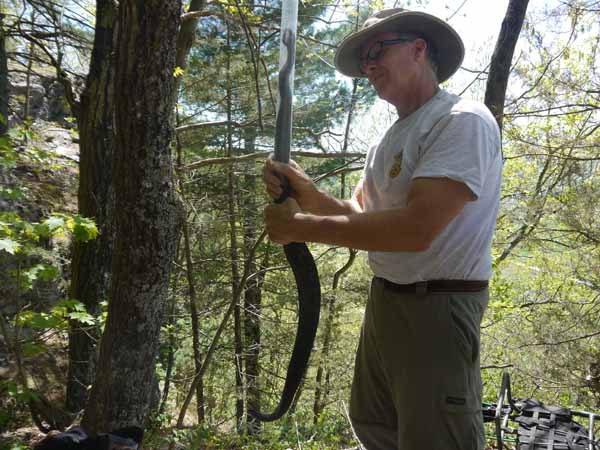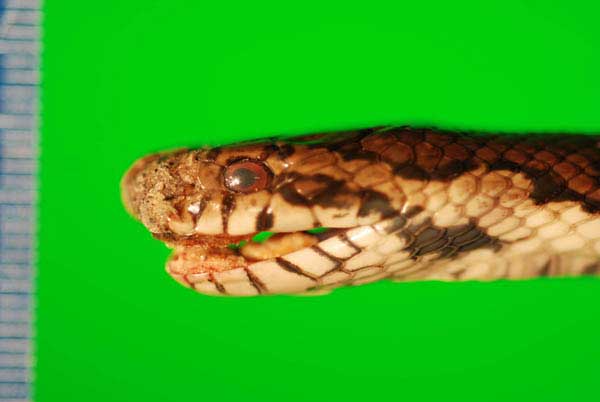By Matt Miller, senior science writer
While studying timber rattlesnake movement patterns and habitat use in Vermont, researchers made a surprising discovery: snakes covered in lesions, particularly around their faces.
Called snake fungal disease, it’s a disease showing up with increasing frequency in snakes around the eastern and midwestern United States. Conservationists fear it could pose a similar threat to snakes as white-nose syndrome in bats.
That’s a scary comparison: white-nose syndrome was first documented in 2007 in New York and has since spread widely, killing millions of bats as far west as Oklahoma. It has recently been raging through caves in the Smoky Mountains and has been verified in Kentucky’s Mammoth Cave National Park. So far, despite many efforts at controlling the spread, the disease rages on. Could snakes face a similar menace?
Timber rattlesnakes don’t move as widely as bats, but they do share some habits. They too hibernate underground in communal dens—often with other snake species. During hibernation, immune systems are suppressed. This combination can create a fertile ground for fungal disease growth and spread.
“There has been a lot of money spent on white-nose syndrome, and a lot of educational outreach, but so far they’ve been unable to stop the spread in bats,” says Emily Boedecker, acting state director for The Nature Conservancy in Vermont. “Snakes are even less appreciated by the public than bats. An emerging disease is a significant concern.”
The research partnership between the Vermont Department of Fish and Wildlife, the Orianne Society and The Nature Conservancy captured snakes to monitor their movements through radio telemetry. But they also weighed and measured snakes, and assessed their health. That’s when researchers found snake fungal disease. It has never been documented in Vermont before, but now it was turning up on numerous snakes.
Snake fungal disease has been documented sporadically in the past, but it began showing up with increasing frequency beginning in 2006. While it has been known to cause mortality, the effects on snake populations is yet unknown – in large part due to the secretive nature of snakes.
“We have more questions than answers,” says Dr. Chris Jenkins, executive director of the Orianne Society. “We don’t know if it’s a big deal yet, but we need to look into it closely.”
Jenkins notes that the disease does not appear to be spreading like white-nose syndrome; it is appearing in different parts of the country at the same time. It’s possible that snake fungal disease is not new but is only now being recognized. “Maybe we just weren’t looking for it,” he says.
When they emerge from hibernation, timber rattlesnakes bask in the sun, which appears to help control the lesions.
Another possibility is that the disease has always been present, but now has been exacerbated by a change in environmental conditions, including climate change.
In Vermont, researchers found that the timber rattlesnake population had relatively low genetic diversity, not surprising given its isolation. “Low genetic diversity and a fungal disease is a combination I find very disconcerting,” says Doug Blodgett, a wildlife biologist for the Vermont Department of Fish and Wildlife.

The problem with wildlife diseases – indeed, any threats to wildlife – is that they are not considered serious threats until it’s too late. It is difficult to predict what will be a minor issue and what will devastate millions of animals – as has turned out to be the case with white-nose syndrome, and fungal diseases impacting amphibians.
While snake fungal disease was not a focus of the Vermont research, it may be one of the most important findings. Hopefully this time conservationists can gather necessary information and develop strategies to stop the disease before it devastates snake populations.
“We know so little about this disease, but now we know it’s here and we can start addressing the issue,” says Blodgett. “We know we can’t ignore it. The past should teach us that.”
Opinions expressed on Cool Green Science and in any corresponding comments are the personal opinions of the original authors and do not necessarily reflect the views of The Nature Conservancy.




snake funagsl diseas is present in world wide area or only present in some part of entire world basically rain forest area.
This is indeed a warning of anthropologic changes to the environment. Not only are we driving climate change, which may be providing the warmer, wetter conditions that favor runaway fungal growth, but one has to think of the countless synthetic chemicals we are drowning the planet with.
Fungal and bacterial resistance to existing medications are devastating enough for human health – what more for the future? Indeed, reptiles and amphibians are simply the tip of the iceberg – IF we were truly intelligent beings, we would be pay attention and take action before it is too late! The question should be, “Have we ALREADY crossed the point-of-no-return?”
There is a fungus affecting the frogs in Costa Rica and Panama.I wonder if it is the same kind?
The reptiles are like the canary in the coal mine and our planet is in BIG trouble!
This is pretty scary! I was horrified at the huge losses of bats through the white nose syndrome…now the snakes.
Hopefully we can find a way to help them.
Excellent article. I was not aware of this disease until I attended a herpetological survey just recently and saw this first hand. It is awful seeing the lesions and the clouded eyes and knowing that chances are these snakes probably aren’t going to survive. The infected snakes were Brown Watersnakes. I just wonder how many species are affected by this disease. I hope with more articles like this and more awareness that this will get more attention and hopefully we can do something before it does get out of control if it isn’t already.